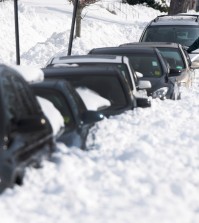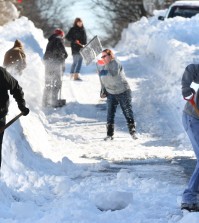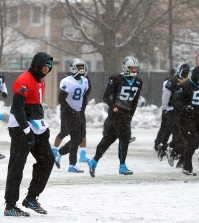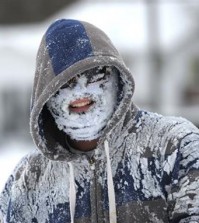- California Assembly OKs highest minimum wage in nation
- S. Korea unveils first graphic cigarette warnings
- US joins with South Korea, Japan in bid to deter North Korea
- LPGA golfer Chun In-gee finally back in action
- S. Korea won’t be top seed in final World Cup qualification round
- US men’s soccer misses 2nd straight Olympics
- US back on track in qualifying with 4-0 win over Guatemala
- High-intensity workout injuries spawn cottage industry
- CDC expands range of Zika mosquitoes into parts of Northeast
- Who knew? ‘The Walking Dead’ is helping families connect
New Englanders slowly dig out of snow after forecasters get it right
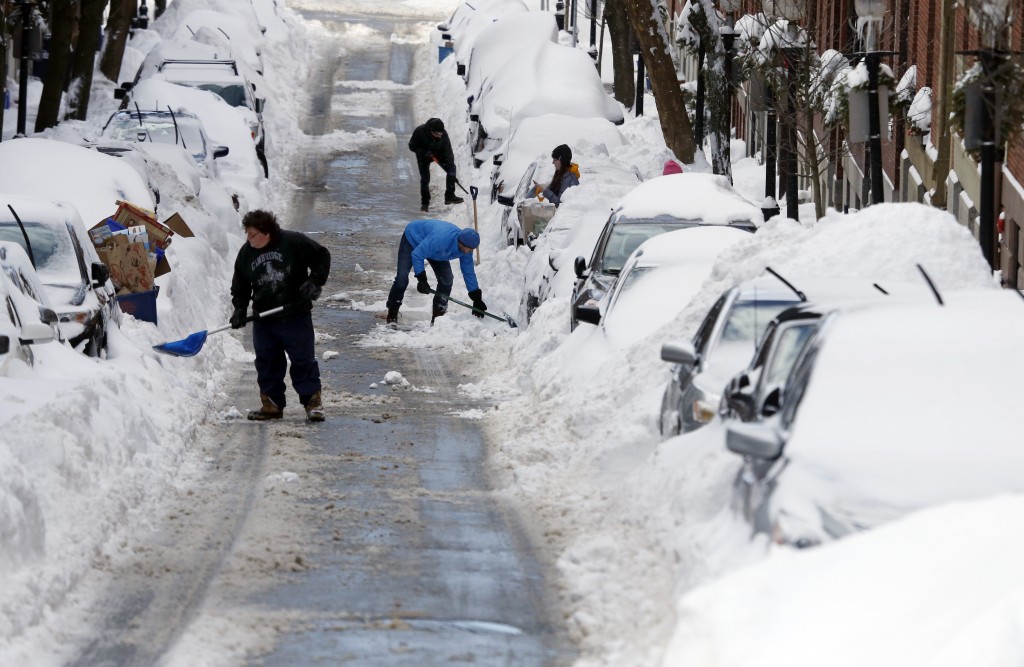
People work to shovel snow-covered cars out in Boston’s Charlestown section, Wednesday, Jan. 28, 2015, one day after a blizzard dumped about two feet of snow in the city. (AP Photo/Elise Amendola)
BOSTON (AP) — Trudging through knee-high snow, New Englanders began digging out from a blizzard Wednesday with grudging respect for the forecasters, who missed the mark in New York but were right on the money in the Boston area.
The storm buried the metropolitan area in more than 2 feet of snow Tuesday and lashed it with howling winds of over 70 mph.
By Wednesday morning, the city was bouncing back quickly. Boston buses, subways and commuter trains were running again, and Amtrak trains to New York and Washington were rolling on a limited schedule. Flights began arriving at Logan Airport just after 8 a.m.
Morning commuters high-stepped their way through a warren of snowy paths and towering snowbanks that gave much of Massachusetts an almost alpine feel.
“I had to jump out the window because the door only opens one way,” Chuck Beliveau said in hard-hit Westborough. “I felt like a kid again. When I was a kid, we’d burrow through snowdrifts like moles.”
As the storm gathered earlier in the week, forecasters had warned that Philadelphia, New York and New Jersey could get 1 to 2 feet of snow. But in the end, they didn’t even see a foot, as the storm tracked farther east than expected and vented most of its fury on New England.
In New England, meteorologists had warned the city would receive more than 2 feet, and the National Weather Service said it got 24.4 inches, the city’s sixth-highest total on record. Other areas received 2 to 3 feet, pretty much as predicted.
“They actually got it right,” James Hansen said as he cleared a Boston sidewalk.
Boston is accustomed to big snowstorms, and with ample warning that a blizzard was coming, officials mobilized thousands of snowplows and called up the National Guard to ensure a speedy recovery.
Early on, Gov. Charlie Baker made a key decision, ordering a driving ban to give crews a chance to clear the mounting snow. Baker said he wrestled with that, but it “worked pretty much as we hoped.”
“We’ve come out of this in relatively good shape,” he said Wednesday.
Still, bitter cold threatened to complicate efforts to clear clogged streets and restore power to more than 15,000 customers shivering in the dark, including the entire island of Nantucket.
Forecasters warned that it won’t get above freezing in Boston for a week, and more snow — though nothing major — was expected later in the week.
Snow blanketed Boston Common, where the Redcoats drilled during the Revolution, and drifts piled up against Faneuil Hall, where Samuel Adams agitated for rebellion against the British.
The storm also punched a gaping hole in a seawall and caused flooding in Marshfield, Massachusetts, and it flipped a 110-foot replica of a Revolutionary War ship in Newport, Rhode Island, snapping its mast and puncturing its hull.
Around Massachusetts, Worcester got 33.5 inches — the highest amount recorded since 1905 — and Auburn and Lunenburg each reported 36 inches.
Parts of the New Hampshire coastline got 31 inches. Burrillville, Rhode Island, got 26.5 inches. More than 20 inches piled up in Portland, Maine, and 33.5 inches in Thompson, Connecticut. Orient, on the eastern end of New York’s Long Island, got about 30 inches.
“Our snowblower broke down a couple of times because it couldn’t handle all the snow,” said Jodi McKim, struggling to free her car in Whitman, south of Boston. “It was a lot of work.”
A 53-year-old man collapsed and died in New Bedford, Massachusetts, while shoveling snow Tuesday night, official said.
Two other deaths, both on Long Island, were tied to the storm by police: a 17-year-old who crashed into a light pole while snow-tubing down a street and an 83-year-old man with dementia who was found dead in his backyard.
In Providence, a man and his two small children were hospitalized with suspected carbon monoxide poisoning after drifting snow covered a boiler vent on their home.
A forecaster outside Philadelphia actually tweeted an apology for the off-target forecast there, and National Weather Service director Louis Uccellini said his agency should have done a better job of communicating the uncertainty in its forecast.
New York Mayor Bill de Blasio again defended his administration’s decision to prepare for the storm by banning travel.
“You can’t put a price on safety,” he said Wednesday on NBC’s “Today” show.








